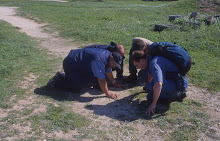venerdì 14 dicembre 2012
Crux
At the beginning of the I canto of Purgatorio, after the introduction, Dante sees four bright star in the dawning sky:
“Io mi volsi a man destra e posi mente
A l’altro polo, e vidi quattro stelle
Non viste mai fuor ch’a la prima gente.
Goder pareva il ciel di lor fiammelle;
o settentrional vedovo sito,
perché privato se’ di mirar quelle”
(I turned right, and I paid attention to the other pole, and I saw four stars, that nobody but the earliest people saw; the sky seemed to enjoy their little flames; oh Northern widow site, because you are deprived of seeing them).
In high school they teach us that the four stars represent the four cardinal virtues: justice, strength, prudence and temperance, and that Dante says that these virtues were known by Adam and Eve (that lived in the Eden at the summit of the mount of Puragatorio, exactly on the South Pole) but are nowadays lost. But in the Divine Commedy symbols never stay on their own, but are closely related to actual things, with the relationship of a metaphor to the object. For instance, “la bufera infernal che mai non resta” (The infernal storm that never rests) of Canto IV of Inferno perfectly reflects the unmoderate passions that shake the lustfuls. Dante’s metaphors and allegories, moreover, are always astonishingly precise. Only many years after high school I realized that, since the four star are exactly above the South Pole, they clearly represent the Crux, that marks the South Pole in the same way as the Plough marks the North Pole. When I first noticed this, I was surprised because in the Middle Age the constellations of the Southern Hemisphere should have been unknown. But the Crux was well known to Arabs, that sailed regularly up to Kenya and Tanzania slightly south of the Equator, and probably Dante, that was strongly influenced by a few Arabic texts, received informations about the Crux from Arabic sources. The Crux is visible south of about 20° N. Therefore probably Dante, when he says “settentrional vedovo sito” (Northern widow site) means Europe and not Northern Hemisphere as a whole. Moreover, he probably thinks that the Cross of the South was known by the Greeks and the Romans, since Cato, that shortly afterwards he will meet, represents the virtuous pagan that still has not lost familiarity with the four stars that were so close to the Garden of Eden. Therefore, I suspect that “la prima gente” (the earliest people) means not only Adam and Eve, but also the ancient people in general. But I’m aware that if you admit that Dante was informed about the Cruz this passage presents some difficulties of interpretation.
Iscriviti a:
Commenti sul post (Atom)


Nessun commento:
Posta un commento